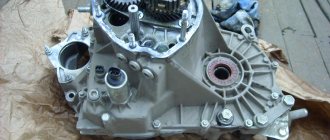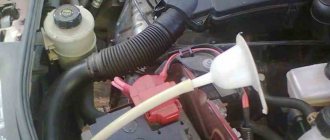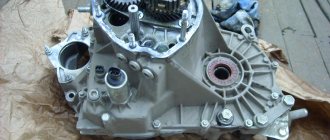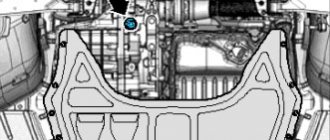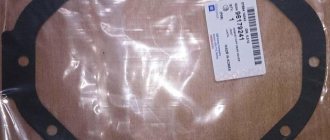How much oil is needed to change an automatic transmission depends not only on the capacity of the box. The replacement method also influences: partial, full or hardware with preemption. And here the age of the machine and the frequency of maintenance are already taken into account. The older the transmission, the more often consumables have to be changed. Purchasing original fluids or high-quality analogues will help reduce the frequency of ATF replacement and extend the life of the machine.
How often to fill the gearbox with oil
The lubricant protects the gearbox from wear.
The frequency of oil changes depends on which gearbox is installed in the vehicle. In addition, the load on the unit plays a big role.
The manual gearbox has a simple design. In it, torque is transmitted to the drive wheels through shafts and gears, which are constantly in contact with each other. If your car has a manual transmission, you need to change the oil at least every 150 thousand kilometers. Cargo transportation, movement over rough terrain, adverse weather conditions - such loads reduce the frequency of oil changes by half.
Automatic transmissions differ in their operating principles, but they are all uniquely more complex than mechanics. The oil in them is the working fluid. It not only lubricates the transmission parts, but also removes heat from the torque converter. For stable operation of the automatic transmission, it is recommended to change the oil in it every 30–50 thousand kilometers.
A CVT is a continuously variable transmission in which torque is transmitted from the engine to the transmission through 2 pulleys. Such a box is very sensitive to slipping, frequent acceleration and deceleration. Aggressive driving wears out pulleys and transmission belts, causing particles from moving parts to contaminate the oil. Therefore, experienced auto repairmen recommend changing the lubricant in CVTs after about 40 thousand kilometers.
A robotic gearbox with two clutches is essentially two manual gearboxes with an electronic control unit that automatically changes gears. In this case, one manual transmission is responsible for even speeds, the second for odd ones. In a manual transmission, many complex parts experience load: clutch discs, servo and hydraulic drives, valve body, etc. In order for a complex unit to serve without interruption, it is recommended to change the oil in it every 50-60 thousand kilometers.
These indicators are approximate - in any case, you should follow the recommendations established by the car manufacturer.
How to determine when it's time to change the oil:
- By mileage
- After purchasing a used car, unless there is reliable evidence of a recent replacement.
- There are jerks and delays when shifting gears
What to pay attention to when changing gearbox oil in order to prevent possible serious damage to the unit:
- used oil smells like burning;
- the amount of work is less than required;
- the used lubricating fluid has become very dark;
- Metal particles were found in the used oil.
But what happens if you ignore the recommendations for changing the gearbox oil? Over time, the lubricating fluid loses its original properties, becomes dirty, foams and thickens. Because of this, the gearbox components stop working as expected, which leads to gear shifting, increased friction losses and an increase in operating temperature. As a result, the gearbox quickly wears out, which can lead to extremely expensive repairs or complete replacement of the unit.
Frequency of replacing transmission fluid in the "Seven"
The schedule for changing transmission oil depends not only on the mileage of the car - for the VAZ 2107 it is 70 thousand kilometers - but also on the operating conditions of the car.
Let us highlight those factors that negatively affect the service life of the oil and reduce the replacement time to 50-60 thousand kilometers:
- Frequent off-road driving, dusty and polluted areas
- High driving speed
- Engine overheating when operating at high speeds
- Climate change, sudden temperature changes
As already written above, the VAZ 2107 was created on the basis of the Italian model of the 1960s Fiat 124. Therefore, it is quite natural that the “Seven” is not suitable for modern operating conditions or too active driving. It is adapted to bad roads in terms of comfort, but not endurance.
How much oil is poured into the gearbox
Since the oil in a manual gearbox primarily performs lubricating functions, its consumption is relatively low. As a rule, 1.6 liters of oil must be added to a 5-speed gearbox, and 1.3 liters to a 4-speed gearbox.
In an automatic transmission, ATF oil is consumed by several key components at once. The torque converter takes about 2 liters, the pump and gears - about 4 liters, the oil line and radiator - about another 2 liters. Consequently, the total oil consumption on an automatic transmission is approximately 8 liters for a passenger car. SUVs require even more oil - about 9-10 liters. If the car is equipped with a variator - an automatic transmission without a torque converter, the oil consumption will be 1-2 liters less. Depending on the number of stages, it is recommended to fill the robotic box with 1.9 to 2.4 liters of oil.
About various automatic transmissions
To begin with, I want to note that today we will talk only about two types of automatic transmissions - a CVT and a classic torque converter automatic. There will be no robot here! Why? YES, everything is just a robotic box, similar in structure to the mechanics, it actually contains little of the same amount - to be precise, about 3 - 4 liters, and it is made using a different technology.
The variator and automatic transmission have their own oil, or rather it is commonly called ATF fluid , it is much thinner, in fact, that is why it is called “fluid”. As a rule, it is used much more in a building. But more on that below.
What kind of oil should I put in the box?
Gearbox oils, like motor oils, are divided based on several groups: more about this in the article “What makes up the cost of motor oil.”
- Mineral oils are produced by distilling petroleum. At the same time, the molecular structure of such a lubricant does not change.
- Synthetic oils - in their production various additives are used that increase the performance properties of the lubricating fluid.
Synthetic oil tends to be thinner at low temperatures and more stable to environmental influences. For example, if mineral oil lubricates all the parts of the box in a few minutes from the moment you start work, synthetics reduces this time to 30–40 seconds. This is especially true for cold starts in winter.
How to pour oil into a gearbox
It is necessary to drain the oil from the gearbox into a special pan.
Changing the oil in a manual transmission is a procedure that can be completed without the help of a mechanic. An important point is that before changing the oil in the box, the lubricating fluid currently used must be warmed up. This will make it easier to drain the oil. To warm up the oil, just drive the car for 5–10 minutes. Next, you can start changing the oil:
- Drive the car onto the overpass.
- Put the car on the handbrake.
- Remove the protective cover from the gearbox and the cap from the breather (pressure equalization valve).
- Clean the breather.
- Unscrew the drain plug.
- Drain the used oil - this usually takes 10-15 minutes.
- Tighten the plug.
- Fill in the required amount of oil using a special syringe.
- Screw on the breather cap.
- Install gearbox protection.
Changing the oil in automatic transmissions and variators is carried out using special equipment at a specialized service station.
Checking the oil level and condition
For preventative purposes, it would be a good idea to regularly check the volume and condition of the lubricant in the gearbox. Experts recommend doing this every 10 thousand kilometers of the car.
You can determine the oil level in the VAZ-2107 gearbox using a screwdriver or other object like a dipstick. You will also need a clean rag and a wire brush.
Place the car on the inspection hole, use a brush and a rag to clean the surface of the box near the oil filler hole. Wipe and unscrew the plug. Place a screwdriver into the hole. The oil level should reach the bottom edge of the filler hole.
Evaluate the appearance of the lubricant. If it is dark and cloudy, or contains sediment, then it will need to be completely replaced - even if the deadline according to the regulations has not yet arrived.
Technical regulations on the amount of transmission substance
Transmission fluid is monitored every 10 thousand km, i.e. during the next maintenance. Before checking the amount of substance, you need to let the car sit for a while. During this period, the transmission fluid will have time to flow down the walls of the box. If the fluid level reaches the edge of the lower edge of the filler hole, then its volume is quite sufficient, and the oil is not replaced or topped up.
How much transmission oil will be needed when completely replacing it directly depends on the type of gearbox. According to the technical instructions, the following volume of liquid is established:
- for 4-mortar – 1.35 l;
- for a 5-mortar – 1.6 l.
Experienced drivers advise filling the 5-mortar with lubricant slightly above the set level - “as much as it will fit.” To do this, lift the car from the driver's door with a jack. Then add 250–300 g of liquid. This will ensure reliable lubrication of the 5th gear gear. There is no need to be especially afraid of increased pressure on the seals, since excess pressure is released through the breather.
Table of volumes of several brands (how much to pour for a complete replacement)
| BRAND | Amount of oil in automatic transmission (in liters, for complete replacement) |
| Hyundai Accent (1994 - 2000) | 4,5 — 5 |
| Chevrolet Cruze | 7,6 |
| Chevrolet AVEO (T300) | 7,6 |
| FORD FOCUS 2 | 5 |
| Hyundai Solaris | 6,8 — 7 |
| KIA RIO | 6,8 — 7 |
| MAZDA 3 | 7,5 — 8 |
| Nissan Almera Classic | 7,8 — 8 |
| Opel ASTRA H-J | 7 — 8 |
This is where I end, I think the article was useful to you. Read our AUTOBLOG.
Similar news
- Why do they install a CVT instead of an automatic? Details + video
- I engaged reverse gear at speed - WHAT WILL HAPPEN? Let's take the car apart...
- Do I need to change the filter in the automatic transmission? When changing the oil? A few words about Sh...
About replacement and how much to fill
Now, probably many people can tell me - but when I replaced it, they only changed 5 liters. how so? Guys, the whole point is that you can change ATF fluid in different ways. Not all automatic transmissions or CVTs can be disassembled. Therefore, the lubricant is simply pumped out from above using a special pump, but this also happens in two steps:
- If your machine does not have a drain plug (or there is no pan for removal), the service station will pump out the oil through the filler neck. But the whole problem is that the master can’t reach the bottom, so 5 liters are pumped out. dirty grease , but you still have about that much left inside.
- Then the technician adds new oil to you and you drive for a while, then, say, after 500 kilometers, you again come to the service station, where they drain half of it again and fill you with the same amount of new oil.
Thus, in two doses, 80–90% of the fluid is changed, although this is not entirely correct. That is, in any case, you will fill in about 10 liters, that’s just how it will be done! Some of the dirty ATF fluid will still remain. So it turns out that you changed 5 liters, but after a certain mileage you will return again.
It is worth noting that the most correct replacement is when you remove the pan (or disassemble the machine), then drain the old “liquid”, change the old filter, clean all the pans, magnets and then fill in new oil. This is how the replacement should be done.


